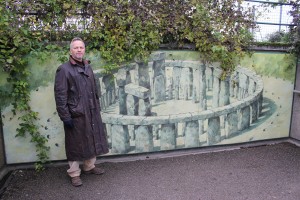Stonehenge – Friday 26th October
It’s been a wet week and Mark Anstee has been largely sealed up in his studio away from the wind and the rain, but today we’re back at Stonehenge to remind ourselves what it looks like.
As well as all the photographs of the stones, and the sheep, and the traffic, and the artist, and each other, tourists to Stonehenge linger on the way out of the monument field to take a photo of the large formica type board half-way down the slope, filled with an illustration of the imagined full and complete Stonehenge circle.
Unfortunately I don’t know who did this illustration because English Heritage doesn’t credit the artist anywhere. It looks like it might have been done in the 1970s, but I’m guessing. It is however, massively photographed by the visiting population. I think people rush past it on the way in, eager to get to the ancient monument, but on the way out, having viewed a disorganised collection of stones, they are suddenly presented with a picture of what it might have actually looked like, and they can stop trying to figure it out, and get a picture that makes sense.
I watch people hovering on the slope, camera in hand, waiting…waiting for that split second when no-one is walking in front of the board. This can take quite some time…
I asked Mark to stand in front of the illustration so I could get a photo of him with it. It looks quite bizarre, but in a good way.
One of the most used and therefore most familiar illustrations of Stonehenge as a complete circle is one done in the 17th Century by the architect Inigo Jones. This is however, regarded in archaeological circles as somewhat inaccurate. Jones based his complete plan of Stonehenge on Roman principles of geometry and architecture. Perhaps in a fine example of shoehorning ‘proof’ to fit the theory, Inigo Jones wanted the structure to be Roman, so his ‘research’ was heavily skewed to prove his theory right. Then along came the next generation of antiquarians and then the next generation of archaeologists, and so the theories keep shifting.
Imagined illustrations are one thing but I think it is really difficult to accurately describe Stonehenge in words. Many descriptions I’ve read in guide books resort to historical or mythological explanations. Written descriptions of what Stonehenge looks like tend to be quite lengthy because what might have been there at one point is not the thing that people see when they visit. Now, the collection of stones is incomplete, but it doesn’t seem right to describe them as a ‘ruin’, because they don’t seem to make sense as an actual building, with walls and a roof; the classic picture one holds when someone talks of something as a ruin.
I’ve attempted my own description of Stonehenge, one that says how it looks to me, today in 2012 and I’ve come up with this:
Stonehenge is a collection of enormous upright, vaguely rectangular rocks, rising out of the rural Wiltshire countryside, close to some major and busy roads. Some of the rocks, or stones, stand singularly, some lay on the ground and some are joined together by huge horizontal blocks resting across the top.
There is evidence of a circular arrangement, emphasised by a circular walkway, a roped area of tarmac and cut grass surrounding the stones at some distance from which the vast number of tourists view the stones as they walk round.
The hordes of people appear to be either on their mobile phones or taking photographs, not just of the stones but of themselves.
(People aren’t necessarily on their mobiles. Most are listening to the audio commentary on the devices handed to them after they’ve paid their entrance fee to get into the field upon which Stonehenge stands.)
